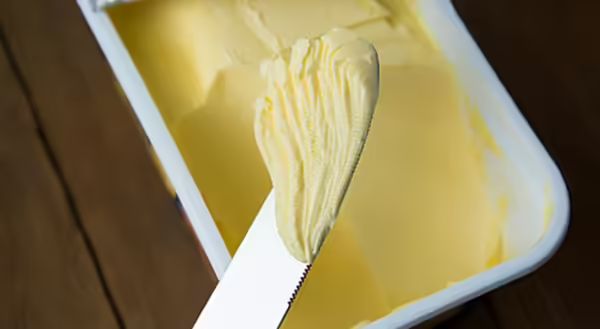
Butter, margarine, and oil are all types of fat used in the kitchen. Whether it's baking, stir-frying, cooking, or using as a spread, fat plays a role in the American diet. The 2020-2025 Dietary Guidelines for Americans recommend limiting saturated fat to less than 10% of total calories. Saturated fat is found in butter, red meat, fish, other animal products, full-fat dairy products, and some prepackaged or processed food. The dietary guidelines suggest a shift from saturated fat, which raises LDL cholesterol (bad cholesterol), increasing the risk of heart disease, to more healthy fats, such as polyunsaturated and monounsaturated fats, found mainly in plant-based sources. The body needs fat for growth, vitamin absorption, hormone function, energy, and more vital purposes, but what is the function of fat in food, and is it necessary?
The melt-in-your-mouth, creamy, rich, and smooth taste sensation are all often associated with fat. Fat can blend flavors of ingredients together or enhance the flavor, such as butter. In baked goods, fat also contributes to the tenderness of a product as it prevents flour from absorbing water. Muffins or biscuits with reduced fat are often tougher because the gluten is more developed. One method to counteract the toughness is increased sugar. Fat can also work as a leavening agent. Adding fat to yeast breads helps gluten spread and stretch, creating a larger loaf of bread.
Shortening is a fat that shortens or delays gluten development making the texture of baked goods easier to chew, flaky, and softer. Shortening can also be generalized as any group of solid fats, typically white and tasteless. There are three different types of shortening: regular, emulsified, or puff pastry. Shortening is 100% fat and solid at room temperature. Most shortening is made from hydrogenated vegetable oil but may contain animal fat. Shortening is high in saturated and trans fats, causing negative effects on heart health. Read more about healthy substitutes below.
Butter is a fat made from cream and 80% fat with 20% water particles with milk solids. Butter enhances flavor. Butter also melts in the mouth, unlike shortening. Shortening can leave an unpleasant taste after eating pastries or icing. Butter and margarine tend to create thinner and crispier baked goods, specifically cookies, because they have a lower melting point than shortening and contain a small amount of water. Reminder: Butter is high in saturated fat.
RECIPE HINT:
What does cream mean? A recipe with the instruction to cream means whipping together butter or shortening with another ingredient, such as sugar. The combination of the two ingredients works in air pockets creating lightness and a natural leavening agent.
Margarine is a fat made from vegetable or other plant-based oils but contains a similar 80:20 ratio as butter. Margarine and butter are used interchangeably. Not all margarine is created equal; some margarine contains trans fats. Margarine with at least 55% oil work best for baking. Oil should be the first ingredient listed on the label. Also, when reviewing the label, look for options with no trans fats--usually the tub margarine has less trans-fat than stick form. Tub margarine is not ideal for baking as they contain more water and less fat.
Oils are fat options that stay liquid at room temperature. Canola and olive oil are just a few heart-healthy monounsaturated fats that work well for cooking, sauteing or baking. Oils help distribute flavor throughout the dish and enhance herbs or other added seasonings. Substituting oil for solid fats such as shortening or butter can cause pastries to be mealy rather than flaky. Substituting oils for solid fats can also result in denser or flat-baked products. When baking with oils, little air is trapped in liquid fat compared to solid, creating a softer and chewier consistency. Oil help transfer heat to food, prevent sticking, helps food retain heat, emulsifies or thickens sauces, and create a crisp texture.
All fat, whether it is olive oil or butter, contains 9 calories (kcals) per gram. Cutting back on fat in baked goods not only reduces the amount of fat in the food but calories as well. Below are simple substitutes for fat in recipes. Remember, every recipe is different, and substitutes may provide a different texture or flavor.
Try a healthier fat substitute:
- Try reducing all fat by 1/3.
- Replace half the fat with applesauce, pureed prunes, mashed bananas, or nonfat yogurt (baking time may be reduced by 25%).
- Applesauce and yogurt can add moisture to a product, so consider reducing other liquid ingredients.
- When substituting pureed prunes, an increase in liquid may need to be added as the product may be drier.
- Bananas have a distinct flavor. When substituting fat with bananas, the banana flavor is masked well in chocolate desserts but not so in sugar cookies.
- Try a vegetable substitute: substitute half the fat with shredded zucchini or purred pumpkin.
- Cut fat down by using skim milk instead of whole milk. Using 1 cup skim milk over whole cuts 70 calories, 8 grams of fat, and 28 milligrams of cholesterol.
- When stir-frying, sautéing, or frying use non-stick cookware, cooking spray, water, or broth to reduce fat.
Finding ways to make healthier favorite recipes is a fun game of trial and error. Start slow with changing ingredients, making small adjustments such as reducing the amount of fat rather than completely eliminating it from the recipe. Healthy substitutes can enhance the flavor rather than hinder the taste just remember the function of the fat in the recipe. Get a group together and take a favorite recipe and try making it a few different ways with the substitutes listed above.
Sources:
- Annrose M. Guarino, Ph.D., "Recipe Substitutes" (2011) Human Nutrition and Food, Louisiana State University, Louisiana Cooperative Extension.
- Gisslen, Wayne. Professional Cooking (2007). John Wiley & Sons, Inc. Hoboken, New Jersey.
- Lauterbach, Sharon and Albrecht, Julie A., "NF94-186 Functions of Baking Ingredients" (1994). Historical Materials from University of Nebraska-Lincoln Extension. Paper 411.